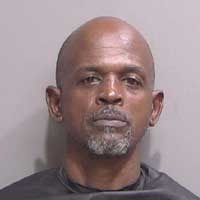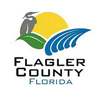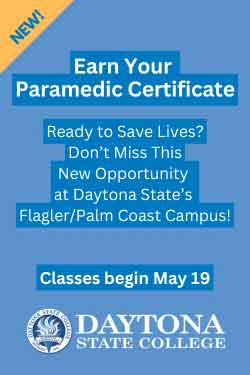
To include your event in the Briefing and Live Calendar, please fill out this form.
Weather: Mostly sunny. Much cooler. Less humid with highs in the upper 60s. North winds 5 to 10 mph with gusts up to 20 mph. Thursday Night: Partly cloudy. Cooler with lows in the lower 40s.
- Daily weather briefing from the National Weather Service in Jacksonville here.
- Drought conditions here. (What is the Keetch-Byram drought index?).
- Check today’s tides in Daytona Beach (a few minutes off from Flagler Beach) here.
- Tropical cyclone activity here, and even more details here.
Today at a Glance:
Are you kidding? Nothing’s going on today! Happy Thanksgiving. Packers and Lions at 1 p.m., Cowboys and Chiefs at 4:30, Bengals and Ravens at 8:20, and if you’re not up for so much stupor, check out Henry James below.

Flagler Cares is in the midst of its Second Annual “Keep the Holiday Lights On” campaign. The health and social care coordinating organization is inviting residents and businesses to support local families in need of a modest financial bridge to keep their power on this holiday season. This initiative encourages neighbors to help neighbors by sponsoring homes to ensure struggling families can keep their lights on through December. The goal is to sponsor 100 homes at $100 per home, covering one month’s electric bill for families who might otherwise face utility cut-offs during the holidays. Supporters are welcome to contribute any amount to help brighten the season for their fellow residents. Donations can be made now through the end of the year on the “Keep the Holiday Lights On” webpage at www.flaglercares.org/holiday. Check donations may also be mailed or dropped off at Flagler Cares, 160 Cypress Point Parkway, Suite B302, Palm Coast, FL 32164. As homes are sponsored, donors can watch the campaign’s progress online as homes on the page light up — a symbol of the community’s shared compassion and care.

Thanksgiving Byblos: Henry James’s “Traveling Companions” is just shy of novella length. It ran in two parts in the November and December Atlantic of 1870. This appraisal is also in two parts. You can read the second part tomorrow.
The story could have been titled “Calvary.” Brooks is an American student in a German university (at Interlaken, sister city of Putnam County’s Interlachen), vacationing in Italy and doing what Henry James characters do on vacation: visiting museums. The story opens with a lyrical appraisal of Leonardo’s Last Supper at the Convent of Santa Maria delle Grazie in Milan, insightful especially for its characterizations of the late 15th century painting’s “tragic twilight of its ruin,” of the “vague outlines and incurable scars; enough remains to place you in sympathy with the unfathomable wisdom of the painter.” You wonder if James, master of the musty unsaid, is not coyly referring to himself. He runs into an American pair admiring the Supper, the “more than pretty enough” Charlotte of Araminta, N.J., and her old, worn father, Mark Evans. (There is no such town; Araminta was the slave first name of Harriet Tubman, who appears to have nothing to do with this story, though with James you never know.) So begins, with that Last Supper scene, the first in a series of Stations-of-the-Cross-like artistic illustrations of Brooks’s next few weeks as he courts Charlotte. It doubles the pleasure of the story to keep an iPad handy to look up the many paintings referenced as Charlotte, once betrothed to a man who did not return from the Civil War, keeps him at arm’s length. She’s not playing hard to get as much as, like that other Civil War veteran, Oliver Wendell Holmes, she lets her realism smother any glimmers of sentiment outside of what she can safely feel when she is looking at art. Art is her refuge and barrier. Charlotte’s and Brooks’s navigation of the asphyxiating conventions of propriety between rich tourists is the subplot of this somewhat schematic story. They cannot, in late 19th century Italy, freely hang out with each other without raising eyebrows, though reading Casanova or Retif de la Bretonne on the previous century’s sexual mores you’d think the 1960s were mere catch-up to former freedoms. But it’s true: the reactionary 19th century put a lid on libertinism, in the pretentious classes especially. The old man’s weariness allows Brooks to escort Charlotte by themselves to the top of Milan Cathedral and its “immense skyward elevation and a fierce blinding efflorescence of fantastic forms of marble.” (I had not known of the maze of marvels offered by the only Gothic cathedral with allowable passage through its terraces.) The Evanses go to Venice. He goes to Vicenza, not far from Venice, where he buys from a “charming, and yet so mendacious and miserable” family the painting of a Madonna and Child the family claims is an original Correggio. He doesn’t believe it. But the portrait reminds him of Charlotte. The symbolism, paid with a reference to Charlotte ironically saying she is glad she’s no Catholic (not a slight, but from relief that she doesn’t boil with passion), is a bit syrupy. The family wouldn’t have sold the fake Correggio but for the seemingly terminal illness that befalls their young daughter. “Her face haunted me. What fatal wrong had she suffered? What hidden sorrow had blasted the freshness of her youth?” Brooks is not haunted for long and the dying girl is forgotten: it isn’t she Brooks will rescue from sorrows but Charlotte. The story abruptly transitions from his thoughts for the dying girl to this: “As I began to smell the nearing Adriatic, my fancy bounded forward to claim asylum in the calmer presence of my bright American friend.” He finds Charlotte in a church, in a praying pose. They have dinner, they spy a young man at a nearby table, giving James, when he has Charlotte wonder where the man is from, a crack at the obligatory bite of supremacy we occasionally find in his stories: “He is made of that precious clay that is common to the whole English-speaking race,” Brooks says. Charlotte imposes a “three days’ probation” on their time together, which intensifies his longing for her.
![]()
The Live Calendar is a compendium of local and regional political, civic and cultural events. You can input your own calendar events directly onto the site as you wish them to appear (pending approval of course). To include your event in the Live Calendar, please fill out this form.
December 2025
East Flagler Mosquito Control District Board Meeting
In Court: Jermaine Williams Status Hearing
In Court: Kristopher Henriqson
Flagler County Commission Evening Meeting
Nar-Anon Family Group
Rotary’s Fantasy Lights Festival in Palm Coast’s Town Center
Palm Coast Charter Review Committee Meeting
Palm Coast City Council Meeting
Flagler Beach United Methodist Church Food Pantry
Weekly Chess Club for Teens, Ages 10-18, at the Flagler County Public Library
Food Truck Tuesday
Flagler Beach Library Writers’ Club
Rotary’s Fantasy Lights Festival in Palm Coast’s Town Center
‘Annie,’ at Limelight Theatre
Random Acts of Insanity Standup Comedy
For the full calendar, go here.

The most strictly impressive picture in Italy is incontestably the Last Supper of Leonardo at Milan. A part of its immense solemnity is doubtless due to its being one of the first of the great Italian masterworks that you encounter in coming down from the North. Another secondary source of interest resides in the very completeness of its decay. The mind finds a rare delight in filling each of its vacant spaces, effacing its rank defilement, and repairing, as far as possible, its sad disorder. Of the essential power and beauty of the work there can be no better evidence than this fact that, having lost so much, it has yet retained so much. An unquenchable elegance lingers in those vague outlines and incurable scars; enough remains to place you in sympathy with the unfathomable wisdom of the painter. The fresco covers a wall, the reader will remember, at the end of the former refectory of a monastery now suppressed, the precinct of which is occupied by a regiment of cavalry. Horses stamp, soldiers rattle their oaths, in the cloisters which once echoed to the sober tread of monastic sandals and the pious greetings of meek-voiced friars.
–The opening of Henry James’s “Traveling Companions” (1870).











































Dennis C Rathsam says
[Disallowed. Do not use this site to spread disinformation. Thanks.–FL]
Pogo says
@Happy Thanksgiving Day
… and may you deserve what you’re thankful for — and be worthy of it, too.
Today, everyday
https://www.google.com/search?q=desiderata
Pogo says
@Why
… just because.
Pass the gravy — please.
https://www.google.com/search?q=religion+as+an+economic+sector+of+us+economy
Welcome, please take a number.
https://www.google.com/search?q=religion+as+an+economic+sector+of+world+economy
Do Not Disturb, FAFO
https://www.google.com/search?q=armaments+as+an+economic+sector+of+us+economy
Ditto, FAFO
https://www.google.com/search?q=armaments+as+an+economic+sector+of+world+economy
Ray W. says
A Business Insider reporter recently interviewed Jon McNeill, a General Motors board of directors member who previously had been a Tesla executive, about “vertical” manufacturing, a process in which a car company manufactures almost all of the parts used in its products instead of contracting out parts like windshield wiper motors with outside parts manufacturers.
Mr. McNeill talked of Tesla using the same windshield wiper motor across all models, unlike GM, which might use one motor for its Tahoes and another for it Traxxes and yet a third for its Corvettes.
He said that this practice told him that there is only one development team assigned to Tesla windshield wiper motors across all models, something BYD does, too, instead of a different windshield wiper motor team assigned to each GM make and model. And this was not “platform sharing”, something all car companies do. This is called “reusing” parts.
In Mr. McNeill’s description:
“Toyota uses completely different heat pumps, wiper motors, and seat actuators for each model. In other words, the guts of a Corolla is almost completely different from the a Camry.”
Wrote the reporter:
“Reusing parts is crucial for any automaker to scale production efficiently and reduce costs. That could be even more true for emerging automakers.
“‘There’s a reason only one [American] auto company has been started and scaled in the last hundred years, and it’s because it’s really hard. It’s really, really hard and it’s really capital intensive’, McNeill said, referring to Tesla. He added that a US EV company like Tesla needs to be ‘absolutely relentless’ at reducing costs.”
But one thing that Chinese EV car companies do differently from American carmakers other than Tesla involves “vertical integration”, which means that not only do Chinese carmakers “reuse” one part across models, but the companies manufacture “in house” their own parts, instead of contracting them out. As an aside, for decades, Honda contracted out carburetor design and manufacture to Keihin. The other three of the Big Four Japanese motorcycle manufacturers contracted out their carburetor work to Mikuni.
Per the reporter, re: “in house” parts manufacturing”, “[t]his level of control can enable automakers to standardize more parts and produce at higher speeds.”
Make of this what you will.
Me?
Numerous automotive magazines post articles about how BYD controls nearly every part in its parts inventory, from headlights to turn signal stalks to suspension pieces. To BYD, an emerging and scaling EV carmaker, curbing costs might be called an economic “first principle.” There are many reasons why BYD can sell its products at such low prices. “Verticle integration” of its parts inventory is but one of those many reasons.
Sherry says
trump’s negotiation tactics are beyond “bullying”. . . now they are being called “blackmail”! This from Politico:
BRUSSELS — Europe’s antitrust chief Teresa Ribera has unleashed a blistering attack on the Trump administration, accusing Washington of using “blackmail” to strong-arm the EU into watering down its tech rulebook.
Commerce Secretary Howard Lutnick said on Monday in Brussels that the U.S. could modify its approach on steel and aluminum tariffs if the EU reconsidered its digital rules. European officials interpreted his remarks as targeting the EU’s flagship tech regulations, including the Digital Markets Act (DMA).
“It is blackmail,” the Spanish commissioner told POLITICO in an interview on Wednesday. “[This] being their intention does not mean that we accept that kind of blackmail.”
Ribera — who as executive vice president of the Commission ranks second to President Ursula von der Leyen — said the EU’s digital rulebook should have nothing to do with trade negotiations. Donald Trump’s team is seeking to overhaul the framework trade agreement he struck with von der Leyen at his Scottish golf resort in July.
The intervention lands at a sensitive time in ongoing trade talks. Washington views the DMA as discriminatory because the large technology platforms it regulates — like Microsoft, Google or Amazon — are nearly all American. It also takes exception to the Digital Services Act, which seeks to curb illegal online speech, seeing it as designed to restrict social networks like Elon Musk’s X.